Brosimum alicastrum Swartz, known commonly as Ramón, ojite, ojuch, mojú and ox (Maya term), is a tree that is native to Mesoamerica and the Caribbean with broad distribution in Mexico (Peters and Pardo-Tejeda, 1982). It is appreciated because it has foliage with high nutritional content, primarily for bovine and caprine livestock, and because of its availability during drought periods (Rojas-Schroeder et al., 2017). B. alicastrum represents an ecologically important element in the floristic composition of low and medium tropical forests in southern Mexico (Gutiérrez-Granados and Dirzo, 2009).
In Mexico, the Maya culture cultivated and consumed the fruits of B. alicastrum, which were even known as the Maya maize due to the importance in the diet represented by this species for the culture (Meiners et al., 2009). The seed, foliage, latex and wood of B. alicastrum has a high economic potential, both for the diet (animal and human) and medicinal and cultural uses (Ramírez-Sánchez et al., 2017; Domínguez-Zarate et al., 2019). The forage (leaves) has 14% crude protein, 3.9% ether extract or fat, 13% ash or minerals and 39% crude fiber. In human nutrition, Ramón seed has proven to be a food high in protein 11.5% and dietary fiber 13% (Sarmiento-Franco et al., 2022). However, even with this importance, currently the species is distributed mostly naturally, with virtually no forest management (Santillán-Fernández et al., 2021a).
Due to its properties in the restoration of degraded soils, B. alicastrum was included in 2019 as a priority species in Mexico's federal program called Sowing Life (Sembrando Vida) which is coordinated by the National Forestry Commission (Comisión Nacional Forestal) and whose objective is to propagate the species with the purpose of reforestation (CONAFOR 2021). In addition, facing a context of climate change and food security, B. alicastrum has become a widely used local resource for animal and human diets (Ramírez-Sánchez et al. 2017). Faced with these scenarios, the demand for specimens (plant and fruit) of B. alicastrum has increased, and with that, the need to generate research regarding forestry topics of the species (Santillán-Fernández et al. 2020, Pedraza-López 2021).
According to Santillán-Fernández et al. (2021b), bibliometric techniques are the most adequate to detect research gaps of a topic in particular where new knowledge must be generated, since they allow generating indicators and mathematical models to characterize the development and evolution of the frequency and quality of texts published around the topic of interest (Malesios and Arabatzis, 2012). The publication of a scientific text is the most effective way to transmit knowledge acquired as a consequence of the research, and its visibility is important for the researchers themselves, the institutions where they work, and for the organizations that finance the research (Sanz-Valero and Wanden-Berghe, 2017).
In the forest sector, bibliometric studies have been conducted for specific topics such as silviculture (Polinko and Coupland, 2020), community forest development (Bullock and Lawler, 2015), use of drones in the determination of forest biomass (Raparelli and Bajocco, 2019), and even to evaluate national forest systems as in the case of India (Hazarika et al., 2003) and Bangladesh (Miah et al., 2008). In addition, evaluating the scientific productivity of forest researchers in Tanzania (Sife et al., 2013) and India (Parabhoi et al., 2017), and of high impact journals in the Journal Citation Reports as Forests (Uribe-Toril et al., 2019).
In Mexico, studies have used bibliometric techniques, such as those by Martínez-Santiago et al. (2017) in forest models; Vargas-Larreta et al. (2017) in forest biometry for the integral management of forests; Reyes-Basilio et al. (2020) in the evaluation of growth rings to estimate the carbon fixation potential; Gallardo-Salazar et al. (2020) in the use of drones for forest management; and Ayala-Montejo et al. (2020) who identify the research needs about carbon and nitrogen dynamics in agro-forestry systems.
However, these studies analyze broad topics in the forestry sector, and they are not centered on the evaluation of a species in particular. The objective of this study was to analyze the spatial-temporal evolution of basic and applied research about B. alicastrum through the bibliometric analysis, to identify areas of opportunity in research that have not been developed.
MATERIALS AND METHODS
Origin of the Information
In this study, only research where the species B. alicastrum was the object of study were considered. The studies where the species mentioned but there was not an analysis or description of were omitted. Elsevier, Springer and Scopus were reviewed, databases of free access journals articles (Latindex, Scielo, Redalyc, Clarivate Analytics, Periodica, Directory of Open Access Journals, and Conricyt), and the free access search engine Google Scholar. The information compiled was complemented with the references available in the book "Publications about Brosimum alicastrum" by Vergara-Yoisura et al. (2014). The texts were gathered from February to May 2021, taking into account the texts available until 2020.
The keyword used in the search was Brosimum alicastrum identifying it in titles and keywords of the publications. In addition, the "snowball" technique was used to obtain the remaining texts, from the list of references of studies found initially (Leipold, 2014). However, since the snowball technique is considered to be a non-probabilistic technique it can present biases in text recovery, since it is more likely that the studies in English are cited (Streeton et al., 2004); it was decided to use the scientific name of the species as a keyword, which allows capturing most of the relevant publications.
Bibliometric Indicators
The variables analyzed from each of the texts were: editing institution, country of editing, the language of publication, and for the case of the scientific articles the name of the journal was also considered, which served to determine the profile of the institutions that publish similar studies to the topic of B. alicastrum. The variables: first author and collaborators served to understand the network of authors involved in the research; year to place the information in a temporal line; institution of the first author and country of origin of the first author to evaluate the frequency of publications of the institutions by country.
The postal code of the institution of the first author served to determine the geographic location of the institution of origin of the information, and in the cases where the postal address did not appear, the name of the institution was found Google Earth® tools, and in the official webpages of the institutions. The title, abstract and keywords were used to categorize the topic that addresses the publication according to the classification of the National Consortium of Scientific and Technological Resources (CONRICYT) (CONACYT, 2021a) for B. alicastrum. Finally, the impact of the publications was determined the number of citations.
For the classification of the texts by area of research, the topics were arranged into nine categories: 1) Ethnography: where texts that relate the species with the Maya culture, studies of paleontology, and history were included; 2) Rural development: texts where the localities have achieved some growth from the use of B. alicastrum, value chain, productive reconversion, economy, and sustainable use; 3) Potential industrial uses: such as the generation of ethanol, medicines, biopolymers, and quality of the wood; 4) Botany: taxonomic, genetic and physiological description of the species; 5) Ecology and anthropic impact: conservation of ecosystems, floristic composition of ecosystems, effects of the species in the soils, impact of anthropogenic activities, resilience of the species, and environmental services (carbon capture, water balance, and temperature regulation); 6) Animal diet: in domestic species such as cattle, sheep, pork, goat, rabbit and chicken; 7) Forestry: viability and storage of B. alicastrum seeds, evaluation of the species in different nursery conditions, silviculture, plant tissue culture, evaluation of pests and diseases, plantations and harvest, agro-silvo-pastoral, wood technology, and reforestation; and, 8) Human diet, gastronomy and beverages.
Finally, the texts were also classified according to the type of academic product (CONACYT, 2021a), into: 1) Scientific article, which included texts published in journals with ISSN (International Standard Serial Number); 2) Book, texts published by editorials with ISBN (International Standard Book Number); 3) Thesis: Undergraduate, Master's and Doctorate's; 4) Manual, including those documents without ISSN or ISBN where instructions are set out for the collection, dissemination and harvest of the species; 5) Complete congress proceedings; 6) Dissemination work, which included newspaper articles, interviews and online texts where opinions or advances are expressed that have not been subjected to a process of scientific review; and 7) Report, which included studies that only describe topics around the species, and were reported as products of research projects.
The capture of variables for the bibliometric analysis was done in a spreadsheet. The original language of each of the texts was respected. During the capture of all the information, some records were standardized, because the information available in the texts was sometimes incomplete or presented with variables (Aguado-López et al., 2009). In addition, special characters were eliminated to ease the analysis, such as: ñ (for n), accents, superscript, subscript, ®, ©, among others.
Analysis with text mining
With the help of the RcmdrPlugin.temis complement of the statistical software R (Bouchet-Valat and Bastin, 2013), the number of texts and bibliographic citations were obtained by year, type of text, category of research, and country of origin of the first author. For the case of Mexico, the frequency of texts by the institution of the first author was also obtained.
Network Analysis
With the Sci2tool software (Börner, 2011), the interactions present between the first authors and collaborators were analyzed with the aim of understanding the consistency in the researcher's work; that is, evaluating if he/she has published only one year or else has been publishing constantly through time, which gives an idea of his/her consolidation in the topic of B. alicastrum. The syntax used in the Sci2tool software was Extract bipartite Network, and for its visualization the Gephi software was used (Bastian et al., 2009).
Finally, of the variable postal code and Google Earth® tools, the geographic coordinates were obtained in tenth degrees (longitude, latitude) of the institution of the first author of each of the texts analyzed. The spatial representation of the number of articles per country was carried out with the geographic package ARGIS® (ESRI, 2021). For the case of Mexico, the potential distribution area of B. alicastrum obtained by Santillán-Fernández et al. (2021a) was spatially associated with the frequency publication of the first author's institutions and the research category per institution.
RESULTS AND DISCUSSION
Scientific production at the international level where the B. alicastrum species was object of study From 1883 to 2020 a total of 308 texts were published where the forest species B. alicastrum was the topic of analysis; this scientific production gave rise to 9622 bibliographic citations (Figure 1). The first study recorded dates from the year 1883; however, since the year 2000 a growing production was found for the topic of B. alicastrum. The period of greatest productivity was from 2002 to 2020 with 72.08% of the total (222 texts), which contributed to an exponential trend in the increase of publications (R2=0.648). The most cited studies where the ones published in the period 2002-2012 which as whole represented 5594 bibliographic citations (58.14% of the total).
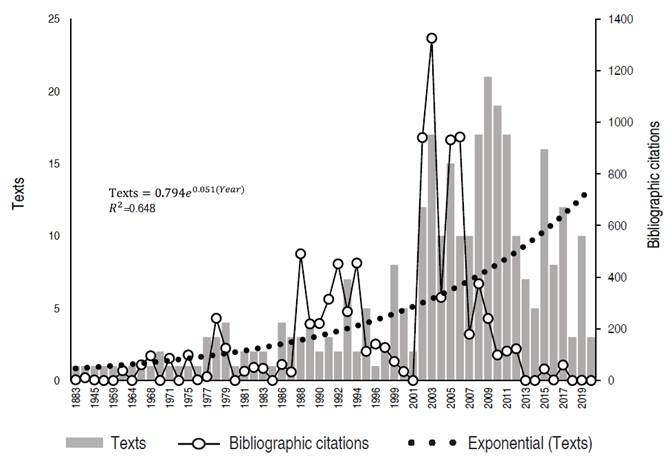
Figure 1 Temporal evolution of scientific texts and bibliographic citations where the species B. alicastrum was object of study from 1883 to 2020.
Vergara-Yoisura et al. (2014) attribute this growth in the number of publications to the diversity of uses of the species particularly in the animal and human diets, which has caused B. alicastrum to be a recurring research topic in southeastern Mexico and Central America. In this regard, Santillán-Fernández et al. (2020) found that within a context of food security, B. alicastrum represents an alternative for food generation. However, Santillán-Fernández et al. (2021c) found that more research is required about the silviculture of the species to ensure constant production of foods, since it is currently a species that is distributed mostly naturally with null forest management.
Regarding the country of origin of the first author in scientific texts, 308 studies were originated in 23 countries. Of them, 84.74% (254) were concentrated in six countries: Mexico (43.83%, 135 texts), USA (United States of America, 25.65%, 79), Guatemala (4.55%, 14), Costa Rica (2.92%, 9), Honduras (2.92%, 9) and El Salvador (2.60%, 8). The fact that the countries with the greatest scientific production are the countries of Latin America where the species B. alicastrum is native stands out (Peters and Pardo-Tejeda, 1982) (Figure 2). Figure 2 also shows that research has been developed around the species in Europe, Africa and Oceania, which helps to explain that 47.40% (146 texts) are published in English and 52.60% (162) in Spanish. This fact is interesting because according to Santillán-Fernández et al. (2021b), the researchers in Latin America publish mostly in Spanish, which lowers the impact of the publications (measured by the number of bibliographic citations).
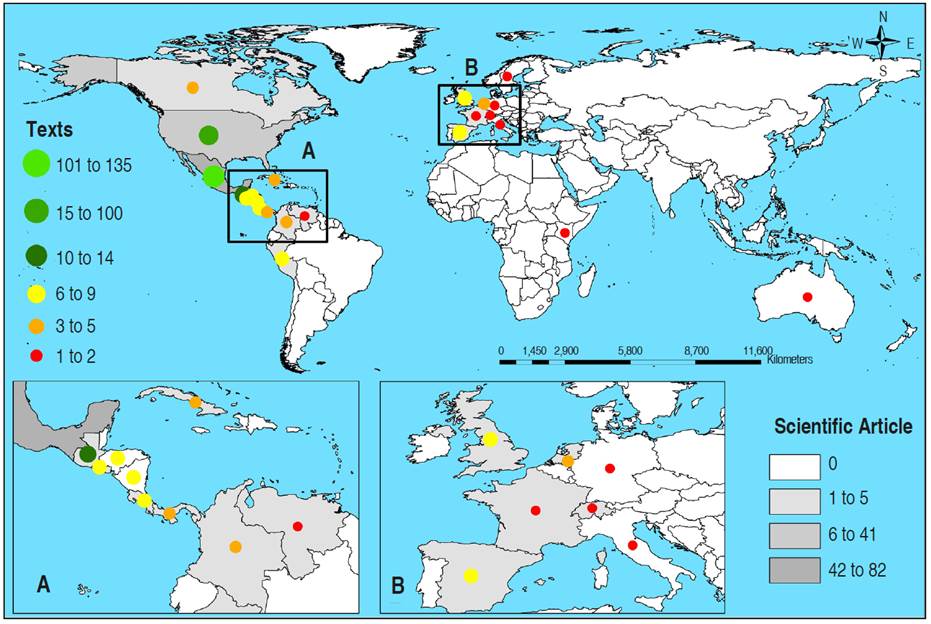
Figure 2 Spatial location at the international level of the productivity of texts where the species B. alicastrum was the object of study from 1883 to 2020. A: Latin American countries; B: European countries.
In the 308 texts analyzed, 251 different first authors were found, and between the first author and the coauthors they added 491 different individuals. The network of authors and coauthors (Figure 3) was made up of 491 nodes (authors) and 411 corners (links). The links in a co-authorship network analysis are important because through them an author can reach certain ideas, knowledge and information that are socially distant for him (Granovetter, 1973). The density of the network had a value of 0.002, which implies that for the topic of B. alicastrum there is not much collaboration between authors. The density is an indicator in the co-authorship network analysis that implies that the nodes interact between each other (they are linked); mathematically it is a value within the interval [0 to 1], and the closer it is to 1 the interaction in the network is higher (Aguilar-Gallegos et al., 2016).
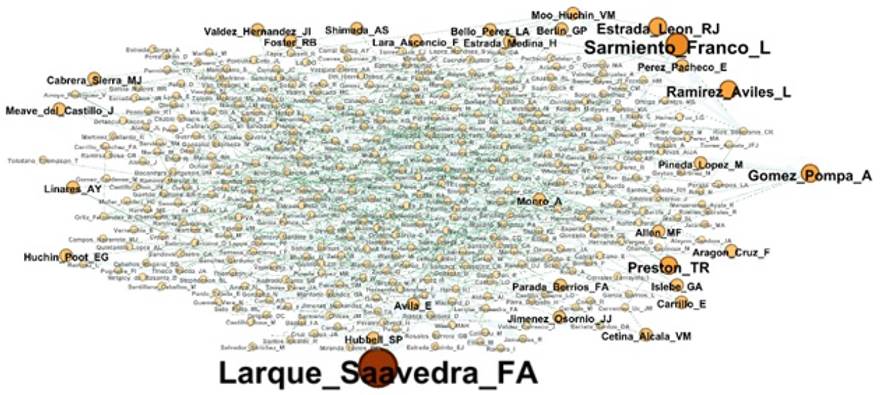
Figure 3 Network of authors and coauthors at the global level who have developed studies where the species B. alicastrum was the object of study from 1883 to 2020. The size of the node corresponds to its productivity.
The low connection of the authors in the research network of B. alicastrum was exposed when a co-authorship mean of 1.59 was found and a mode (139) of one author per text; in addition, 56 texts presented two authors, and only 23 texts were developed by six authors or more. In addition, 185 institutions (from 308 texts) were found, pointed out as the adscription of the first author. According to Santillán-Fernández et al. (2021c), the low connection between authors is explained by the null forest management of the species, which limits the knowledge about its potential uses and promotes the development of the focalized study since it is an emerging topic.
The institutions with the highest frequency (≥10 scientific texts) were institutions in Mexico, located in the south of the country, where the highest abundance of the species is concentrated (Santillán-Fernández et al., 2021a): 1) UNAM (Universidad Nacional Autónoma de México), 17 texts, principal author Gomez_Pompa_A, who developed studies about the botanical description of B. alicastrum; 2) UADY (Universidad Autónoma de Yucatán), 14, Sarmiento_Franco_L, whose studies describe potential uses of the species in the animal diet; and 3) CICY (Centro de Investigaciones Científicas de Yucatán), 13, Larque_Saavedra_FA, whose studies describe potential uses of the species in the human diet. It should be highlighted that Larque_Saavedra_FA was the author with the most contributions with a total of 15 (four as principal author).
Bibliometric Indicators
From the 308 texts analyzed, 49.68% (153) were scientific articles that as a whole reached 89.95% (8655) of the total bibliographic citations (Table 1). According to Bravo-Vinaja and Sáenz-Casado (2008), from the statistical validation of the studies and the peer review that gives feedback with constructive criticism of the research, scientific articles have a higher probability of being taken as reference to generate new knowledge. Table 1 shows that the first published study about the topic of B. alicastrum was a book in 1883. Since 1935, a constant production of scientific articles was observed, in contrast of texts such as manuals and reports. Santillán-Fernández et al. (2021c) attribute this phenomenon to the incipient research developed about the species, which has made researchers seek to publish their findings as scientific articles to generate a greater impact their results.
Table 1 Frequency and bibliographic indicators of the most cited studies per type of text where the species B. alicastrum was the object of study from 1883 to 2020.

Table 1 also shows that the studies with the highest number of bibliographic citations per type of text were published in English. According to Li and Zhao (2015) the publication of scientific texts in a language other than English limits the number of bibliographic citations, since English is the language adopted as universal by the scientific community. The fact stands out that none of the studies most frequently cited by type of text was developed by researchers in Mexico, where the species B. alicastrum is native and widely distributed (Peters and Pardo-Tejeda, 1982). Santillán-Fernández et al. (2021b) found that the low relevance of the research in Mexico (measured by the number of citations) is due mostly to the publication of the studies in Spanish.
From the studies with the highest number of bibliographic citations by type of text (Table 1), it was found that the scientific article (532 bibliographic citations) that corresponds to a study where the benefits of the species B. alicastrum for reforestation of degraded spaces are described. For the case of the manual (343), methodologies about the sexual propagation of the species are described; and regarding Doctorate Thesis (158), potential uses of the species in the animal and human diets are addressed. Vergara-Yoisura et al. (2014) found that there is a broad margin of action to develop research about the species B. alicastrum, particularly in topics of forest management, because presently the distribution of the species is completely natural with practically null forest management.
The research studies where more knowledge regarding the species B. alicastrum has been developed were ecology (18.5%, 57 texts), forestry-reforestation (15.26%, 47), botany (13.31%, 41), animal diet (12.01%, 37), human diet (11.04%, 34) and potential uses (11.04%, 34) (Table 2). These results agree with what was reported by Santillán-Fernández et al. (2021c), who found that the topics related ecology and botany of the species have been the most developed given its incipient forest management.
Table 2 Temporality and frequency per type of text and area of research of studies where the species B. alicastrum was the object of study from 1883 to 2020.

However, when analyzing the temporality of the studies (Table 2), it was found that the topics associated animal and human diets, as well as the description of potential uses in medicine and as fuel, were the first research topics developed (1883-2020); this fact is explained by the influence that B. alicastrum had as food in the flourishing of Maya culture that settled in southeastern Mexico (Vergara-Yoisura et al., 2014). On the contrary, the topics silviculture and nursery were the most recent research areas to be developed (1987-2018), because the species is distributed mostly naturally (Santillán-Fernández et al., 2021a), which according to Santillán-Fernández et al. (2021c) are presented as areas of opportunity to generate new knowledge about forest management of the species.
Scientific Articles
From the 308 texts analyzed, 153 were scientific articles that were published in 97 scientific journals. Of the scientific articles, 28.76% (44) were concentrated in 10 scientific journals, which also represented 30.97% (2681) of the bibliographic citations for scientific articles (Table 3). Among these 10 main journals, 9 were from American countries: Mexico (4), USA (4), and Venezuela (1). For the case of the journals in Mexico and Venezuela, they mostly published in Spanish and did not have JCR (Journal Citation Reports) impact factor or had a low factor that placed them in the categories Q3 and Q4. The journals with the highest number of bibliographic citations published in English and showed JCR impact factors higher than 1, which allowed them to be placed in categories Q1 and Q2 (WoS, 2021).
Table 3 Bibliometric indicators of the main journals that published scientific articles at the international level where the species B. alicastrum was the main topics of study from 1883 to 2020, ordered according to the number of articles published.
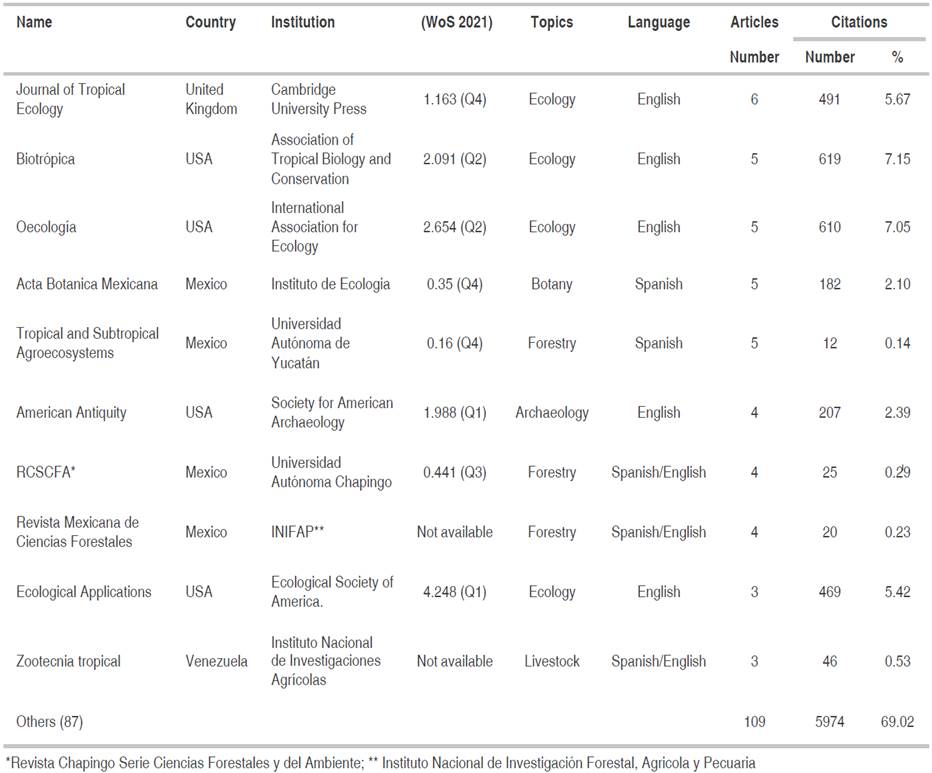
Table 3 shows that in journals of Latin American countries, topics associated with forestry and livestock production topics have been published, and in journals of English-speaking topics related the ecology of the species. Santillán-Fernández et al. (2020) found that the current research about B. alicastrum is focused on evaluating its properties and potential uses, which is why the development of research in forestry topics constitutes an area of opportunity (Santillán-Fernández et al., 2021c), to guarantee the prime material of an emergent livestock agroindustry around B. alicastrum due to its high potential in the diet of porcine, bovine, ovine, poultry and aquatic species (Rojas-Schroeder et al., 2017) within the framework of food security (Ramírez-Sánchez et al. 2017) and climate change (Santillán-Fernández et al., 2021a).
Among the 10 most frequently cited studies about the species B. alicastrum, seven belong to a first author whose institution of adscription is in the USA and only one study corresponds to a researcher in Latin America (Panama); they have all been published in English and in journals of English-speaking origin with impact factors higher than 2 (Q1 and Q2) (WoS 2021) (Table 4). However, the fact stands out that the study areas are located spatially in Latin America: Mexico (4), Panama (2), Guatemala (1) and Costa Rica (1), where the species presents a broad natural distribution (Peters and Pardo-Tejeda, 1982).
Table 4 Bibliometric indicators of the main texts where the species B. alicastrum was a topic of study from 1883 to 2020, ordered according to the number of bibliographic citations.
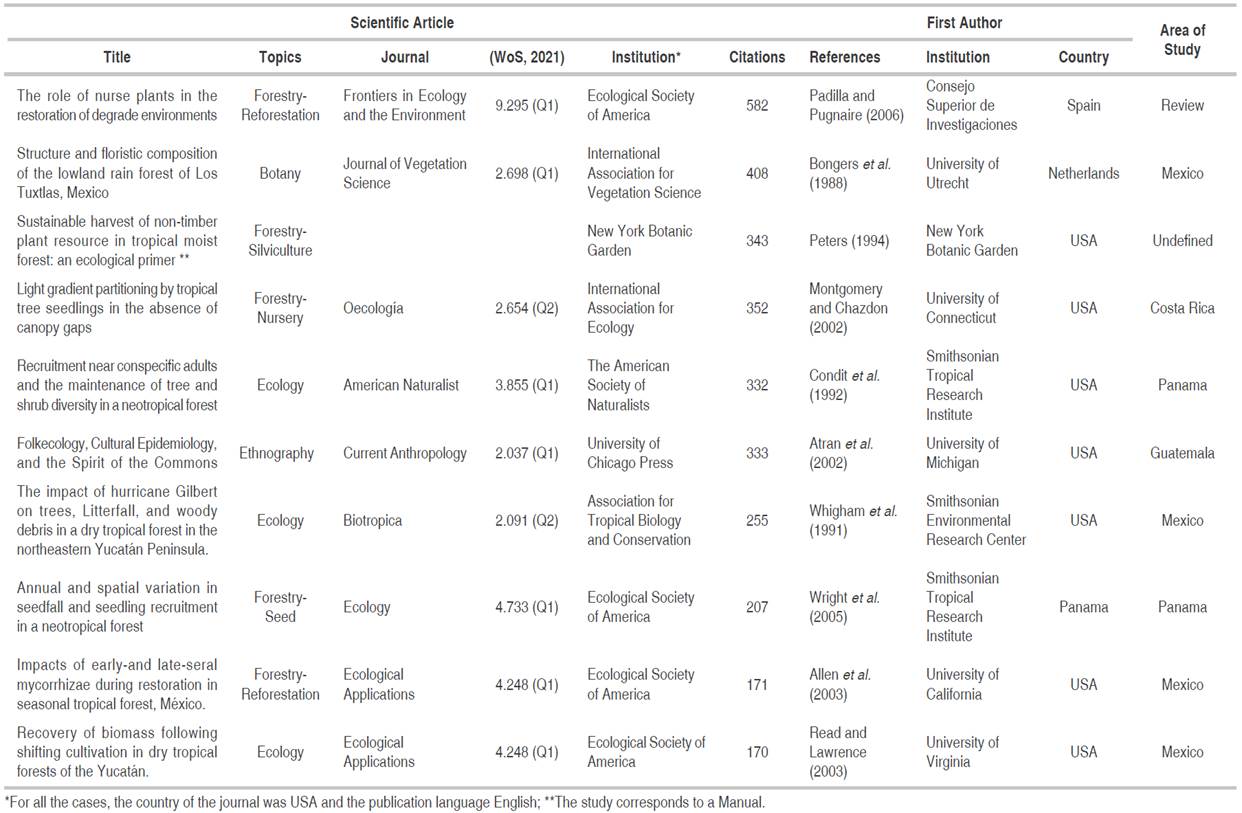
According to Gersbach and Schneider (2015), countries with consolidated economies such as the USA invest more in their research centers, which allows them to develop studies outside their borders and to achieve greater technological development, compared to underdeveloped economies such as the Latin American where the investment in research is lower. Therefore, strengthening international co-authorship networks constitutes a viable option to generate new knowledge in regions of interest with external investments (Aguado-López et al., 2009).
Scientific production on the topics of B. alicastrum in Mexico from 1949 to 2020 Mexican researchers published 135 scientific texts about the topic of B. alicastrum. This productivity represented 43.83% of the total texts found (308), which agrees with the fact that Mexico is the place where the greatest wealth of the species is found in Latin America (Santillán-Fernández et al., 2021a). For the 135 texts, 1763 bibliographic citations were recorded, which represented 18.32% of the total citations (9622), 44 texts did not present bibliographic citations. The texts, 69.63% (94) were published in Spanish and the rest, 30.37% (41), in English. The low level of research (measured by the number of bibliographic citations) that is developed in Mexico has been documented by Santillán-Fernández et al. (2021b), Martínez-Santiago et al. (2017) and López-Leyva (2011), who found that elements such as the language of publication (Spanish) and the priority in the publication of studies whose authors belong to the same institution that edits the journal, restrict the constructive criticism of peer review and reduce the visibility of the publications.
From the 135 texts, 72 (53.33%) are developed in eight out of 41 institutions, taking as reference the institution of adscription of the first author; 60.74% (82) were scientific articles, and 39.26% (53) other types of texts. The institutions with the highest productivity were: UNAM (16 studies), UADY (15), CICY (13), INECOL (Instituto de Ecologia A. C., 7), UdeG (Universidad de Guadalajara, 6), UV_Tuxpan (Universidad Veracruzana campus Tuxpan, 5), ColPos_Ver (Colegio de Postgraduados campus Veracruz, 5) and ColPos_Camp (Colegio de Postgraduados campus Campeche, 5) (Table 5). According to CONACYT (2021b), these institutions have strengthened their postgraduate programs in the biological and agro-silvo-pastoral sciences in the National Register of Quality Post-Graduate Programs (Padrón Nacional de Posgrados de Calidad, PNCP), which has allowed them to take initiatives for the development of research on the species B. alicastrum.
Table 5 Main research institutions in Mexico that published scientific texts on the species B. alicastrum.
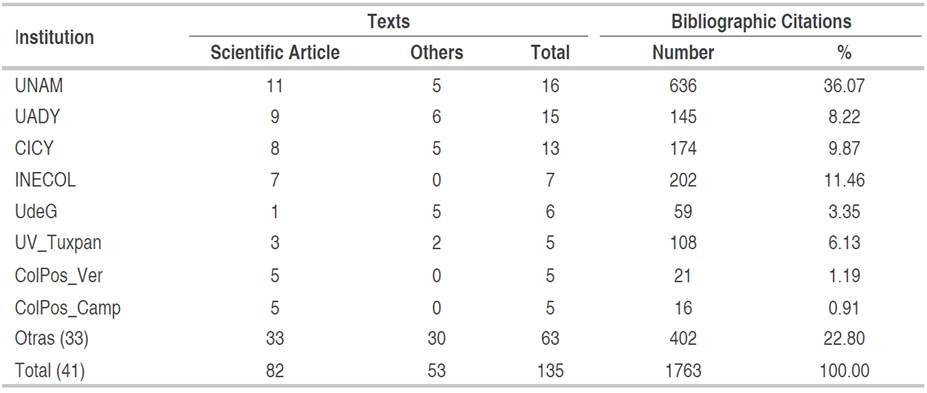
The spatial distribution of institutions with productivity of scientific texts on the species B. alicastrum (Figure 4) allowed establishing that the study of this topic is located in southeastern Mexico and agrees with the natural distribution area of the species. In contrast with research topics such as transgenic maize (Santillán-Fernández et al., 2021b), estimation of forestry biomass species in forests (Vargas-Larreta et al., 2017), and forest models (Martínez-Santiago et al., 2017), where the research institutions were not spatially located in the areas where the studies were conducted, it was found that this gap made the transference of technology difficult and affected the quality of the studies. According to Santillán-Fernández et al. (2021c) for the case of B. alicastrum, the fact that the institutions were located in the distribution area of the species can be a factor of success for the generation of new knowledge to have a greater impact.
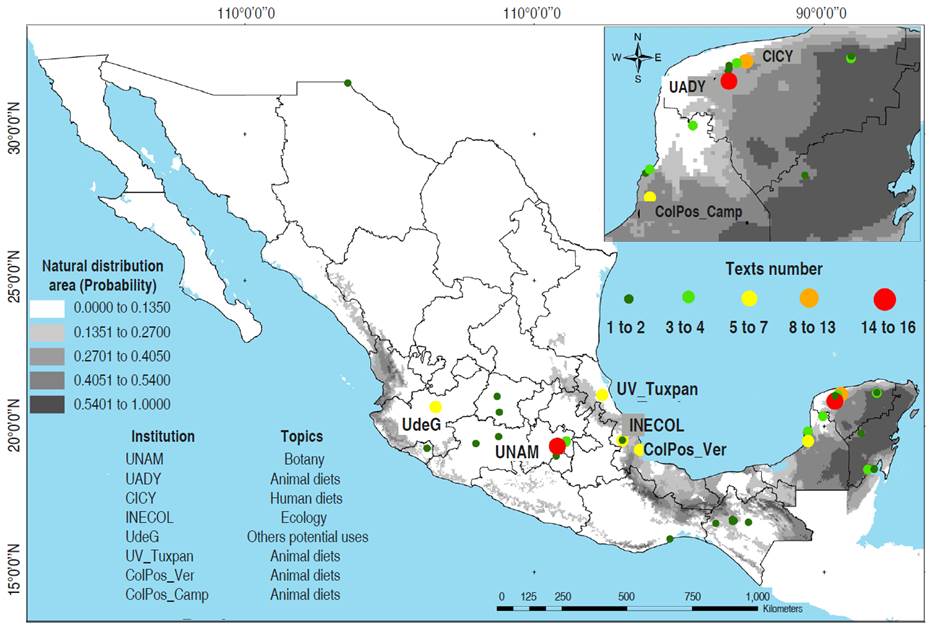
Figure 4 Spatial relationship of the academic and research institutions in Mexico that have developed studies where the species B. alicastrum was the object of study from 1883 to 2020, with the potential probability of natural distribution of B. alicastrum taken from (Santillán-Fernández et al., 2021a).
The spatial representation also allowed differentiating the topics of specialization by research institutions. Vergara-Yoisura et al. (2014) consider that with the creation of the CICY in 1979 the development of research around the species B. alicastrum was potentiated, which allowed developing areas regarding its potential uses in animals (UADY, UV_Tuxpan, ColPos_Ver and ColPos_Camp) and human diets (CICY), which complemented the research about the botany of the species (UNAM). Rojas-Schroeder et al. (2017) and Ramírez-Sánchez et al. (2017) consider that the framework of food security of institutions in southeastern Mexico had to develop studies about the local plant resources with alternatives for animal and human diets, and one of the species with the greatest potential is B. alicastrum.
However, Santillán-Fernández et al. (2021c) consider that the development of research around the species of B. alicastrum for the topics of botany, and its uses in animal and human diets, should be complemented with the generation of new knowledge about sexual and asexual reproduction of the species, management in nursery, silviculture, and development of plantations, with an agroindustry of foods where the prime material B. alicastrum is guaranteed.
CONCLUSION
The spatial-temporal evolution of scientific production showed an exponential growth of scientific texts worldwide where the forest species B. alicastrum was a research topic from 1883 to 2020. The principal productivity was concentrated in countries of the Americas where Mexico (43.83%, 135 articles) and the USA (25.65%, 79) dominated. However, in contrast with the studies developed in the USA, those from Mexico did not have a relevant impact (measured by the number of bibliographic citations) as a result from the publication in journals edited in Spanish, when the impact journals are led by English-speaking countries, in English. The topics of greatest relevance were those related to ecology (18.51%), reforestation (15.26%), botany (13.31%), and uses in animal diets (12.01%), and human diet (11.04%). This evidenced a research void in topics related with silviculture of the species with special relevance in their propagation, management in nursery and forest plantations. For the case of Mexico, it was found that the research about this topic was focalized in southeastern Mexico, and it was led by UNAM topics of botany, UADY (animal diet) and CICY (human diet). The spatial location of the main research institutions in Mexico coincided with the area of the natural distribution of the species, which can be a factor for success for the generation of new knowledge to have a greater impact, by facilitating the transference of technology, particularly if it is considered that the research around the topic of B. alicastrum is incipient.















